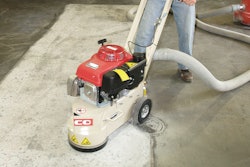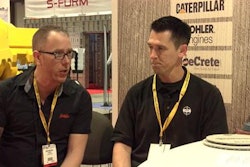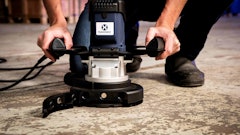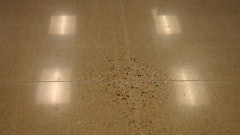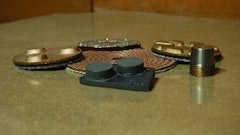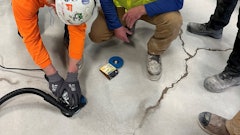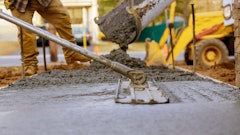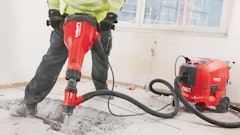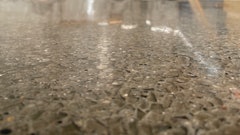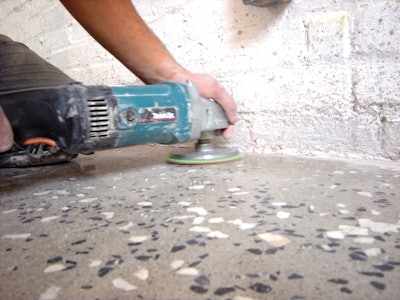
A polished concrete floor project can be a tough job to bid because of the many variables a contractor needs to consider — labor, abrasives, the floor itself, just to name a few. Derek Mackenzie, president of Floorlab in Toronto, Ontario, says a lot of this difficulty stems from the nature of concrete polishing. "The reality of polished concrete is we are the only flooring tradespeople who manufacture a floor on site working with the conditions of the job and existing materials, meaning the concrete floor," Mackenzie says. "Everyone else has quality control materials produced in a factory, like wood and tile." This reality, he says, means polishing contractors need to be prepared for anything and be ready to adjust for variables on the jobsite. It also makes defining a job's cost upfront an even greater challenge.
Harry Gressette with Polished Solution, Inc., Sarasota, Fla., emphasizes the importance of qualifying a bid, in other words, describing how you will handle all the unknowns and what ifs you might uncover on the job. Qualifying a bid helps you offer a reasonably accurate bid price upfront, but also provides protection against the unexpected and the out of the ordinary.
A strong history of job costing gives Gressette a good idea of his costs based on a number of variables, including size of the job, new or old construction, type of building (school, retail, hospital, etc.), requirement for 6- or 7-step refinement process, and so on. These variables tell him how many crew members he will need, how many pieces of equipment he will need on site and how much travel will cost. Other variables like lineal feet of edges and diamond requirements based on the mix design might take a little more digging but can usually be accurately determined at bid time. Other variables, however, like guessing a price for spall repairs on concrete you haven't seen, is the kind of variable that would require a bid qualifier.
This list of tips will help you better determine costs before you turn in your bid to a general contractor or home owner.
Repairs. Planning for repairs can be one of the most challenging issues a contractor will face when bidding an existing floor project. "With repairs, there are a lot of unforeseen issues that can arise. A lot of times you go to a project and you can't see the floor because of an epoxy coating or glues and mastics that remain after carpet or tile comes up. So you have to give a price without seeing the floor," Mackenzie says. "One thing to remember is sometimes toppings like carpeting and tile were put on a floor because the concrete was bad in the first place."
Gressette says this is where qualifying a bid is important. "Spall repair can eat your lunch," he says. "I usually allow so many spalls per square foot and cover them in the bid." Spall repairs required beyond the allowance in the bid are priced out in an addendum to the bid, as are necessary crack repairs and spalling along joints.
Utilities. You need to make sure power in the correct voltage will be available to you on site. If it is not, the power for your equipment will need to come from portable generators. "I have it in my contract that all power will be paid by the customer," Mackenzie says. The same goes for water.
Construction schedule. Find out how much time you have to perform your work and during what times of the day you can do it. If you are working under a tight schedule, or working a job on an existing building still being used for business, you may find yourself confined to do your work nights and weekends. If that is the case, you will need to pay your employees a premium and consider those extra labor costs in your bid.
Job schedule. A job schedule, i.e., a plan that lays out when certain trades will be in a building and who they will be working around, is typically not accurate at bid time, so be prepared to be flexible when it comes time for your crew to get on site.
What is especially important to pay attention to in that job schedule, however , is mainly two things: floor protection and walls. You may have to arrange for floor protection before and/or after your polishing job. Be sure it is clear in the bid who is responsible for installing floor protection and who will pay for it.
You will also need to know if you will be polishing before or after the walls are built. "If you get the floor before walls are up, you will have minimal edge work," Mackenzie says. "But if walls are in you will have to consider the extra edge work in your bid." Speak of edges ...
Edges and handwork. "I figure edges on every job," Gressette says. "If you don't, you're going to go out of business. This is where all the hard work is." His company's job costing histories on various projects give him a figure for his edging costs per linear foot. Your edging costs should also include handwork necessary to grind and polish steps, embeds like floor drains and pipes, or any other spot where you stop your floor grinder and have to pull out smaller tools. "Edges could double your price if you have a lot of small rooms on a project," Gressette adds.
Gressette says a good way to get an idea of the amount of handwork and edges you will have to do is ask the general contractor for the as-built drawings of the structure. The as-built drawings will give reflect changes that were made to the original plans and give you the most accurate look at the building.
Samples. Make it clear to your clients that samples and mock-ups are not free. They take time and resources. "I charge between $1,000 and $1,500 for a sample," says Mackenzie. "If I get the job, that cost goes away. Charging helps you attract the people who are serious."
Gressette says he also charges for mockups and samples, typically anywhere between $1,500 and $2,500. "We used to do it for free, but it didn't pay off," he says. Like Mackenzie, if Gressette is awarded a job the price the client paid for a mock-up is deducted out of the contract.
Abrasives. There are several factors that will affect your abrasives costs, including hardness of concrete and the number of steps you are required to perform throughout the grinding and polishing process.
Cut. Cream, salt and pepper, or aggregate – if the desired cut of the floor is not clear in the specifications, make sure it is before you submit your final numbers on the job. You will see your profit disappear if you bid for a cream cut and have to spend extra money on abrasives to handle an aggregate cut.
Floor flatness. On new construction projects, Gressette asks for a floor flatness report before he starts grinding so he knows exactly what FF and FL numbers he is dealing with. He explains how these numbers can affect the polisher in describing two retail chain store projects his company completed in recent years. One floor had an FF50/FL30, the other an FF25/FL20. Gressette says the FF25/FL20 floor required 35 percent more labor and increased his diamond expenditure by 12 percent.
Low FF numbers will also affect the clarity of the floor at the end of a project. Make sure you client understands how deep undulations can produce a wave effect on a finished floor. If this is a finish the client cannot live with, talk about it before you start grinding.
Joints. Most specifications will require the polisher to do joint work on the floor. While a saw cut control joint might be 1/8-inch wide, a construction joint can be ½ inch wide. Your joint filler material needs will vary depending on the types of joints in your floor. That material isn't free; plan for that amount in your bid. If you find out on the job you are running short, you might have to pay high costs for shipping in extra to the jobsite – costs that will come out of your pocket.
Mix design. Find out the mix design of the concrete. It will tell you the psi of the concrete, which is one factor in determining your diamond usage for a project. "Contractors should also know that an over sanded mix can eat up diamonds," Gressette adds.
Disposal. Take a look at you job and decide if it will be a wet grind or dry grind. You will need to factor into your bid equipment and costs for dust control or slurry disposal.






